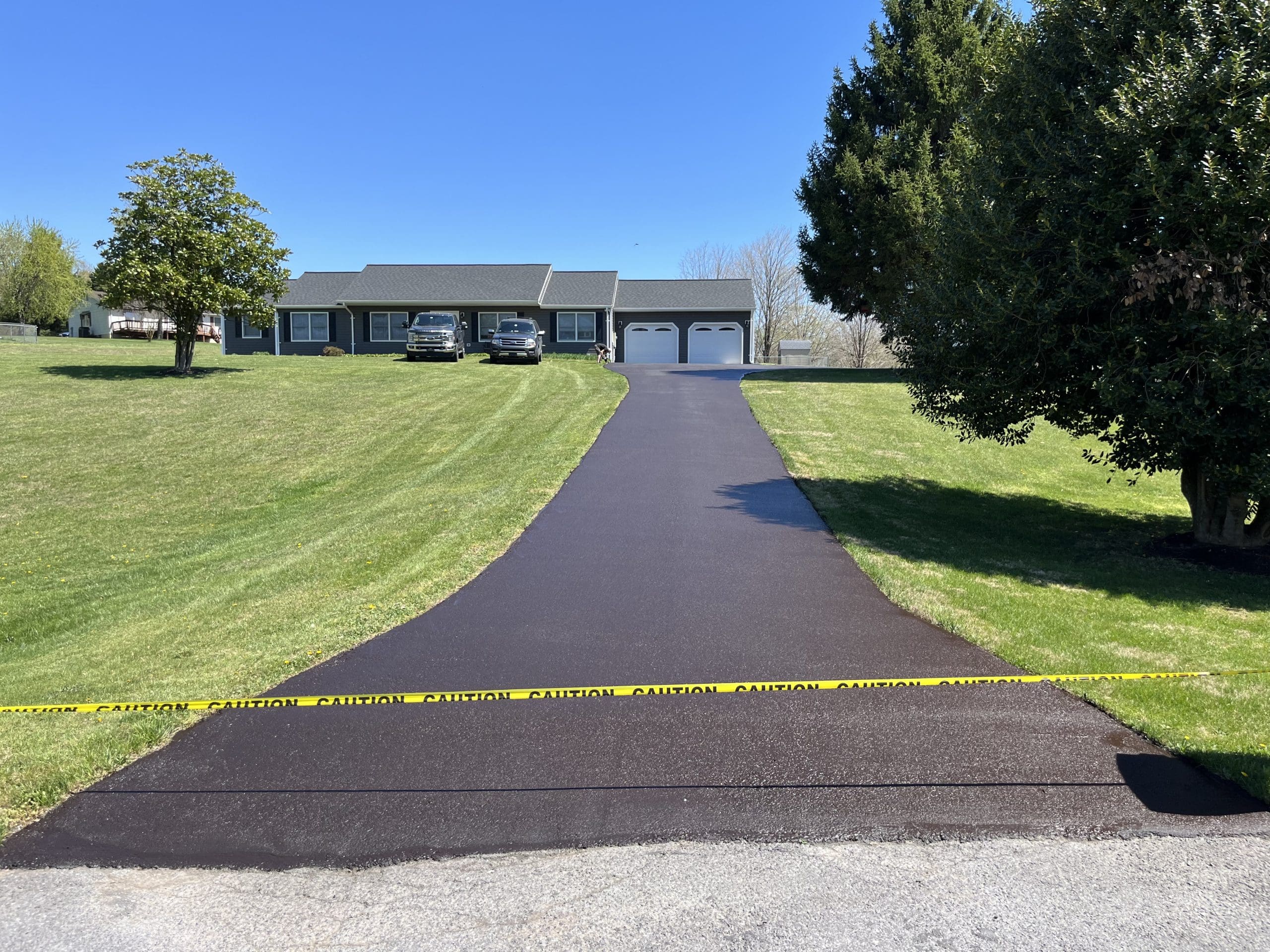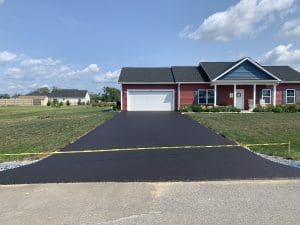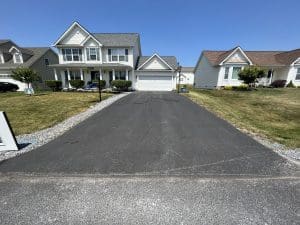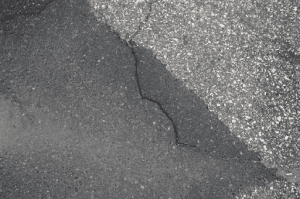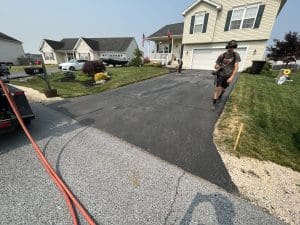Avoiding Common Sealcoating Mistakes: A Guide from Top Gun Sealcoating
Maintaining the strength and resilience of asphalt surfaces is a paramount concern, and sealcoating emerges as the frontline defense in this battle. However, sealcoating is not immune to missteps, leading to subpar outcomes and wasted resources. To ensure you sidestep these common pitfalls, we’ve gathered wisdom from industry professionals. In this article, we’ll delve into the essentials of sealcoating, unveil prevalent mistakes to avoid, share expert strategies for successful sealcoating, and highlight the indispensability of professionals in this process.
Grasping the Basics of Sealcoating
Before delving into the realm of dos and don’ts, let’s establish a foundation by understanding the essence of sealcoating. In simple terms, sealcoating entails applying a protective sealant layer onto an asphalt surface. This barrier serves as a shield, fending off natural elements like sunlight, rain, snow, and chemicals.
Sealcoating, a preventive practice, entails coating the surface with coal tar or asphalt-based emulsion. This forms a protective layer that shields asphalt from oxidation, UV rays, and moisture-induced harm.
Proper sealcoating holds the key to preserving the integrity of asphalt surfaces. It effectively forestalls the emergence of cracks, potholes, and other surface defects triggered by environmental exposure. Furthermore, sealcoating elevates the appearance of asphalt and elongates its lifespan, translating into savings by averting costly repairs and replacements.
Several crucial factors come into play when dealing with sealcoating. The timing is of the essence, primarily during warmer months with rain-free forecasts. This optimal weather allows the sealant to cure and adhere optimally.
Another pivotal aspect of sealcoating is surface preparation. Before applying the sealant, meticulous cleaning of the asphalt surface and eliminating debris, oil stains, and plant growth are prerequisites. This guarantees that the sealant bonds effectively with the asphalt, offering maximum protection.
Moreover, it’s worth noting that sealcoating isn’t a one-time solution. To uphold the integrity of the asphalt surface, periodic reapplication of sealant is a necessity. The frequency of reapplication varies, contingent on factors such as traffic density, climate conditions, and the asphalt’s overall state.
Beyond the functional benefits, sealcoating proffers aesthetic merits. A freshly sealcoated asphalt surface exudes cleanliness, smoothness, and diligent upkeep. This heightened visual appeal significantly enhances residential property curb appeal and leaves a favorable impression on commercial establishments.
In conclusion, sealcoating stands as an essential upkeep practice for asphalt surfaces. It supplies armor against environmental influences, thwarts surface impairments, and elongates the asphalt’s life span. By mastering the fundamentals of sealcoating and adhering to proper procedures, you pave the way for your asphalt surfaces to thrive for years to come.
Steering Clear of Sealcoating Missteps
Sealcoating errors can significantly compromise the efficacy and endurance of the protective layer. By evading these prevalent pitfalls, you can ensure optimal results.
Sealcoating assumes a pivotal role in maintaining the endurance and allure of asphalt surfaces. Yet, being mindful of potential missteps that can undermine sealant effectiveness is crucial. Let’s explore some common missteps encountered during the sealcoating process.
Inadequate Surface Preparation
Successful sealcoating hinges on meticulous surface preparation. Neglecting thorough cleaning, overlooking dirt, debris, and vegetation removal, or disregarding pre-existing cracks and potholes can impede sealant adhesion. To ensure proper surface prep, initiate with a high-pressure washer to cleanse and rectify any prevailing damage.
In surface preparation, precision counts. Failing to eliminate all dirt and debris can erect a barrier between the sealant and asphalt, hampering adhesion. Similarly, ignoring present cracks and potholes invites water intrusion beneath the sealant, accelerating deterioration.
Ahead of sealant application, a thorough surface inspection for damage is imperative. By addressing these concerns beforehand, you create a smooth foundation for a long-lasting sealcoating application.
Incorrect Sealant Application
Misapplication of sealant is another frequent pitfall. Some may apply the sealant thinly, leading to inadequate protection, while others might apply it thickly, resulting in prolonged drying times or a tacky surface. Following manufacturer guidelines regarding recommended thickness and drying duration ensures precise application.
Precision is key in sealant application. A thin sealant layer exposes asphalt to UV rays, water, and other environmental threats. Conversely, an excessively thick layer yields an uneven surface and prolonged drying periods.
Adhering to the manufacturer’s guidelines for thickness and drying time ensures a robust, enduring protective layer, stretching the asphalt surface’s life span.
Insufficient Drying Period
Allowing ample drying time is pivotal for optimal outcomes. Rushing this phase can trigger premature wear and compromise sealant efficiency. It’s advised to abstain from using the treated surface for at least 24 hours post-application or as indicated by the manufacturer.
Patience is the virtue in sealcoating. Allowing adequate time for sealant drying and curing is vital for effectiveness. Premature walking or driving can damage or dislodge the sealant, impairing its protective capability.
It’s important to note that drying times may vary based on temperature and humidity. Adhering to manufacturer recommendations and affording adequate drying time guarantees sealant solidity and desired protective performance.
By evading these common missteps and adopting necessary precautions, you set the stage for a triumphant sealcoating project. Proper surface prep, precise sealant application, and sufficient drying time are critical elements for optimal outcomes. Remember, a well-maintained sealcoating significantly prolongs the lifespan of your asphalt surface, economizing your time and resources in the long haul.
Expert Guidelines for Effective Sealcoating
For achieving sealcoating excellence akin to professionals, here are some expert pointers that can substantially influence the quality and longevity of results.
Selecting the Appropriate Sealcoating Material
When opting for sealcoating material, weigh factors such as climate, traffic intensity, and asphalt condition. Regional disparities entail distinct requirements. Consult with professionals or research reputable brands to pinpoint the ideal sealant for your specific demands.
Optimal Conditions for Sealcoating
Sealcoating should ideally transpire during mild weather conditions, with temperatures exceeding 50 degrees Fahrenheit. Abstain from sealcoating in the event of anticipated rain or high humidity within 24 hours. Optimal conditions ensure adequate sealant drying and curing, maximizing efficacy.
Post-Sealcoating Maintenance
Even with meticulous sealcoating, regular upkeep remains vital to sustain the surface. This encompasses consistent sweeping to eliminate debris, refraining from using sharp tools on the surface, and swiftly repairing any ensuing cracks or potholes. Routine assessments and proactive upkeep extend the lifespan of both the sealcoating and the underlying asphalt.
The Role of Professionals in Sealcoating While embarking on a DIY sealcoating journey is viable, certain scenarios warrant the expertise of professionals.
When to Rely on Professionals For extensive surfaces, substantial repairs, or if you lack the requisite equipment and expertise, enlisting the services of a professional sealcoating contractor is the optimal path. They possess the know-how, experience, and appropriate tools to tackle sealcoating tasks efficiently, yielding top-tier outcomes while sparing you time and energy.
Advantages of Professional Sealcoating Services Professional sealcoating services extend manifold advantages. Contractors are well-versed in industry best practices and utilize premium materials, leading to a sealant layer with enhanced longevity. Additionally, they can pinpoint and rectify underlying issues like cracks and potholes before sealant application, guaranteeing a comprehensive and effective sealcoating endeavor.
Choosing a Dependable Sealcoating Contractor When enlisting a sealcoating contractor, conduct thorough research on their reputation, experience, and client reviews. Request references and compare multiple quotes to secure a dependable professional capable of delivering optimal outcomes for your asphalt surface.
In summation, a firm grasp of sealcoating basics, evasion of common errors, and adherence to expert advice ensures a triumphant sealcoating endeavor. Whether you opt for a DIY approach or engage professionals, proper sealcoating proves a worthwhile investment in the endurance and appearance of your asphalt surfaces. Keep these insights close, and you’ll steer clear of common sealcoating missteps, reaping the rewards of well-preserved asphalt surfaces for the long haul.
